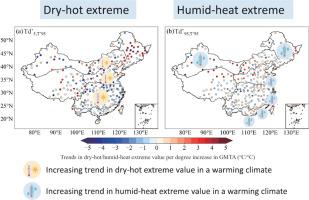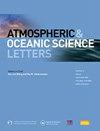The evolving distribution of humidity conditional on temperature and implications for compound heat extremes across China in a warming world
IF 3.2
4区 地球科学
Q3 METEOROLOGY & ATMOSPHERIC SCIENCES
引用次数: 0
Abstract
The likelihood of extreme heat occurrence is continuously increasing with global warming. Under high temperatures, humidity may exacerbate the heat impact on humanity. As atmospheric humidity depends on moisture availability and is constrained by air temperature, it is important to project the changes in the distribution of atmospheric humidity conditional on air temperature as the climate continuously warms. Here, a non-crossing quantile smoothing spline is employed to build quantile regression models emulating conditional distributions of dew point (a measure of humidity) on local temperature evolving with escalating global mean surface temperature. By applying these models to 297 weather stations in seven regions in China, the study analyzes historical trends of humid-heat and dry-hot days, and projects their changes under global warming of 2.0°C and 4.5°C. In response to global warming, rising trends of humid-heat extremes, while weakening trends of dry-hot extremes, are observed at most stations in Northeast China. Additionally, results indicate an increasing trend in dry-hot extremes at numerous stations across central China, but a rise in humid-heat extremes over Northwest China and coastal regions. These trends found in the current climate state are projected to intensify under 2.0°C and 4.5°C warming, possibly influenced by the heterogeneous variations in precipitation, soil moisture, and water vapor fluxes. Requiring much lower computational resources than coupled climate models, these quantile regression models can further project compound humidity and temperature extremes in response to different levels of global warming, potentially informing the risk management of compound humid-heat extremes on a local scale.
摘要
本研究利用非交叉分位数平滑样条, 对中国七个气候分区的297个气象站分别建立了分位数回归模型, 模拟露点温度基于局地温度的条件概率密度分布对全球变暖的响应, 并预测了这些分布分别在2.0°C和4.5°C温升情景下的变化. 结果表明, (1) 这些分布对全球变暖的响应存在较大的区域异质性: 东北地区, 西北地区与沿海地区大多数站点呈现出极端湿热事件增加的趋势; 而中国中部地区的多个站点呈现出极端干热事件增加的趋势. (2) 这些趋势预计在2.0°C和4.5°C的温升情景下将进一步加剧.

全球变暖背景下中国湿度随温度变化的演变及其对复合极端高温的影响
随着全球变暖,极端高温发生的可能性不断增加。在高温下,湿度可能会加剧热对人体的影响。由于大气湿度取决于水分有效性,并受气温的制约,因此随着气候的持续变暖,预测以气温为条件的大气湿度分布变化具有重要意义。本文采用非交叉分位数平滑样条建立分位数回归模型,模拟露点(一种湿度度量)随全球平均地表温度升高而变化的局部温度条件分布。通过对中国7个地区297个气象站的模拟,分析了中国湿热日和干热日的历史变化趋势,并预测了全球变暖2.0°C和4.5°C下的变化趋势。在全球变暖的影响下,东北大部分台站的湿热极端事件呈上升趋势,干热极端事件呈减弱趋势。此外,研究结果表明,中国中部多个站点的极端干热事件呈增加趋势,而西北和沿海地区的极端湿热事件呈上升趋势。在当前气候状态下发现的这些趋势预计将在升温2.0°C和4.5°C时加剧,可能受到降水、土壤湿度和水汽通量的非均质变化的影响。与耦合气候模型相比,这些分位数回归模型所需的计算资源要少得多,可以进一步预测不同全球变暖水平下的复合极端湿度和温度,可能为局部尺度上的复合极端湿热风险管理提供信息。摘要本研究利用非交叉分位数平滑样条,对中国七个气候分区的297个气象站分别建立了分位数回归模型,模拟露点温度基于局地温度的条件概率密度分布对全球变暖的响应,并预测了这些分布分别在2.0°C和4.5°C温升情景下的变化。结果表明, (1) 这些分布对全球变暖的响应存在较大的区域异质性: 东北地区, 西北地区与沿海地区大多数站点呈现出极端湿热事件增加的趋势; 而中国中部地区的多个站点呈现出极端干热事件增加的趋势. (2)这些趋势预计在2.0°C和4.5°C的温升情景下将进一步加剧。
本文章由计算机程序翻译,如有差异,请以英文原文为准。
求助全文
约1分钟内获得全文
求助全文
来源期刊

Atmospheric and Oceanic Science Letters
METEOROLOGY & ATMOSPHERIC SCIENCES-
CiteScore
4.20
自引率
8.70%
发文量
925
审稿时长
12 weeks
 求助内容:
求助内容: 应助结果提醒方式:
应助结果提醒方式:


